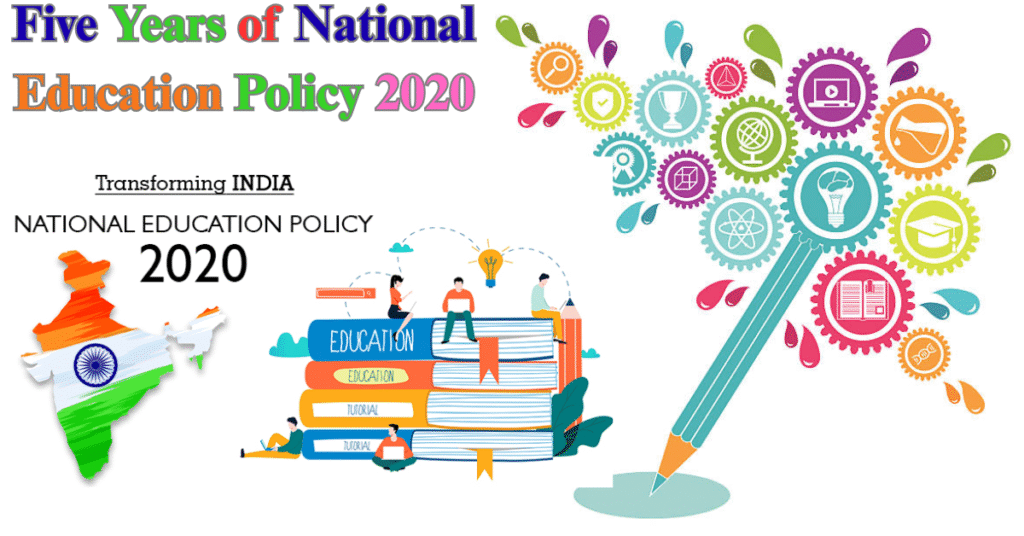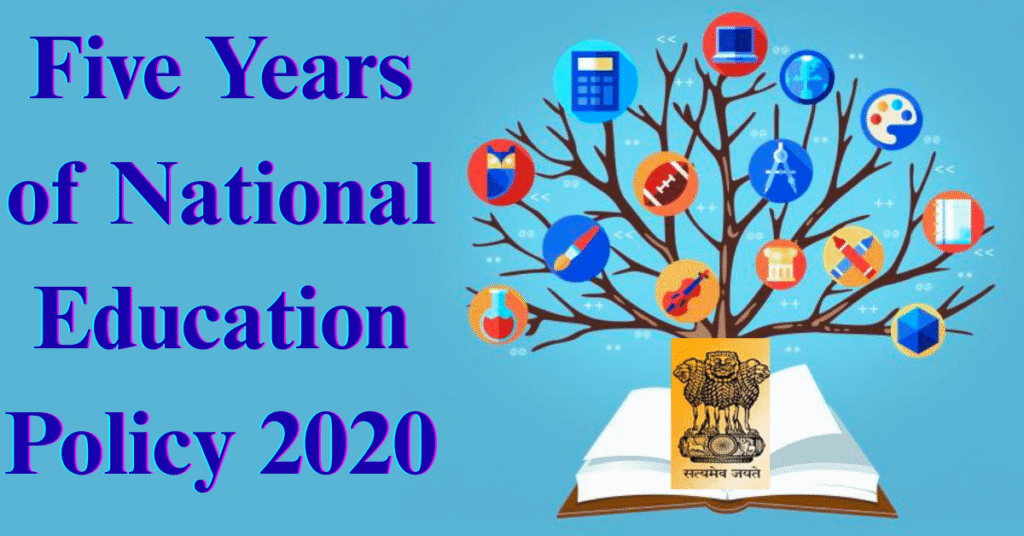
Table of Contents
Five Years of National Education Policy 2020
Five Years of National Education Policy 2020
On July 29, 2020, the Union Cabinet approved the National Education Policy (NEP) 2020, replacing the 1986 Policy (modified in 1992). This was only the third such policy since India’s independence and came after more than three decades. The NEP 2020 aims to overhaul India’s education landscape—from early childhood care and education (ECCE) to higher education and research—in alignment with the needs of the 21st century.
Five years on, implementation is underway, with visible outcomes in some areas, while several crucial reforms remain stuck due to infrastructural limitations, federal challenges, and institutional inertia.
National Education Policy 2020 marks five years of implementation. Explore key changes in school and higher education, from curriculum reforms to CUET, and the progress made so far.
✅ What Has Been Achieved: Key Milestones of NEP Implementation

Five Years of National Education Policy 2020
📘 1. A New School Structure: 5+3+3+4 Replaces 10+2
The NEP has replaced the old 10+2 schooling system with a new 5+3+3+4 model that corresponds to the cognitive developmental stages of children:
- Foundational Stage (ages 3–8): 3 years of pre-school + Classes 1–2
- Preparatory Stage (ages 8–11): Classes 3–5
- Middle Stage (ages 11–14): Classes 6–8
- Secondary Stage (ages 14–18): Classes 9–12
To operationalize this, in 2023, the National Curriculum Framework for School Education (NCFSE) was released, focusing on competency-based learning, reduced content load, and multilingual education.
✅ New NCERT textbooks for Classes 1–8 are aligned with this framework and feature integrated learning.
📚 Example: Social sciences are now taught as one subject, combining history, civics, geography, and economics.
🔜 Textbooks for Classes 9–12 are expected by 2025, as per NCERT’s update.
🎒 2. Early Childhood Education: A Foundational Pillar
The NEP 2020 emphasizes universalizing Early Childhood Care and Education (ECCE) by 2030. This is perhaps the most ambitious and critical component of the policy.
Key initiatives:
- Jadoo Pitara: NCERT’s bilingual, play-based learning kits rolled out in 2023 to aid foundational learning.
- National ECCE Curriculum Framework issued by the Ministry of Women and Child Development to guide Anganwadis and preschools.
- Minimum Age for Class 1: States like Delhi, Karnataka, and Kerala have begun enforcing the minimum age of 6 years for Class 1 entry as per NEP guidelines.
📊 Enrolment Impact:
In 2023–24, Class 1 enrolment dropped from 2.16 crore (2022–23) to 1.87 crore, likely due to this age revision.
✅ However, 73% of enrolled Class 1 students had attended preschool, showing growing alignment with NEP.
🚧 Challenges:
- Many Anganwadi centres lack trained staff and adequate infrastructure.
- Capacity building and integration between ministries remain ongoing efforts.
📖 3. Foundational Literacy and Numeracy: NIPUN Bharat Mission
Launched in July 2021, NIPUN Bharat (National Initiative for Proficiency in Reading with Understanding and Numeracy) aims to ensure:
“Every child in India attains foundational literacy and numeracy by the end of Class 3 by 2026–27.”
📝 According to the Foundational Learning Study 2022 by NCERT (covering 86,000 students across 10,000+ schools):
- Language proficiency: 64%
- Mathematics proficiency: 60%
📌 This indicates moderate progress, but still far from the goal of universal foundational literacy.
📚 4. Academic Bank of Credits (ABC) and National Credit Framework (NCRF)
The NEP 2020 promotes flexibility and lifelong learning. To implement this:
- The UGC launched Academic Bank of Credits (ABC) in 2021.
- National Credit Framework (NCRF) was introduced in 2022 for schools and higher education.
🎓 Highlights:
- Students can earn, store, and transfer credits across institutions.
- Certificate (after 1 year), Diploma (after 2 years), or Degree (after 4 years) is possible.
- CBSE schools were invited in 2023 to pilot NCRF credit-based learning at the school level.
💡 Significance: This facilitates dropout re-entry, multi-disciplinary education, and skilling integration.
🧪 5. CUET: A Common Test for College Admissions
One of the most significant NEP recommendations was reducing the reliance on board marks and multiple entrance exams.
In line with this, the Common University Entrance Test (CUET) was launched in 2022 by the National Testing Agency (NTA).
📌 CUET is now the standardized gateway for undergraduate admissions in Central Universities and many private institutions.
🧠 Why it matters:
- Provides a level playing field for students from different boards.
- Allows multiple subject combinations and flexibility in choosing career paths.

🌏 6. Globalization of Indian Education
The NEP encourages internationalization of education. In the past year:
- IIT Madras set up a campus in Zanzibar, Tanzania.
- IIT Delhi is expanding to Abu Dhabi.
- IIM Ahmedabad has started operations in Dubai.
On the flip side:
- University of Southampton (UK) opened a campus in India.
- Two foreign universities are operational in GIFT City, Gujarat.
- 12 more global institutions are under consideration as per the UGC Foreign Universities Regulations 2023.
Five Years of National Education Policy 2020
🔄 What’s Still in Progress or Partially Implemented
🧾 1. Board Exam Reforms
The NEP envisions less stressful, more frequent, and modular assessments.
- From 2026, CBSE plans to offer Class 10 board exams twice a year.
- Karnataka has already implemented this model on a pilot basis.
📚 Teaching subjects at two levels (standard & higher) is still limited to CBSE Class 10 Mathematics, despite NEP recommendations.
📝 2. Holistic Progress Cards
NEP proposes report cards that include cognitive, emotional, and social development, beyond just marks.
- PARAKH (Performance Assessment, Review, and Analysis of Knowledge for Holistic Development), a unit under NCERT, has designed such report formats.
- However, adoption by state boards and CBSE is yet to be widespread.
🎓 3. Four-Year Undergraduate Degrees
A major NEP recommendation is four-year UG degrees with multiple entry/exit points:
- Year 1: Certificate
- Year 2: Diploma
- Year 3: Regular Degree
- Year 4: Research Degree / Honors with Research
🏛 Implementation Status:
- Central Universities like DU, JNU, BHU, and Visva Bharati have adopted the 4-year format.
- State-level implementation is patchy.
- Kerala has begun adapting the structure.
- Faculty shortages and limited infrastructure are slowing full rollout.
Five Years of National Education Policy 2020
⚠️ Challenges to NEP 2020 Implementation
- Centre-State Coordination:
- Education is a concurrent subject, leading to policy disagreements, especially on issues like language policy, curriculum control, and funding.
- Infrastructural Deficit:
- Many schools lack labs, digital classrooms, and basic facilities.
- Anganwadis and preschools need urgent modernization.
- Shortage of Trained Teachers:
- Both at early childhood and higher education levels.
- Digital Divide:
- Online learning, digital credit systems, and hybrid models have limited access in rural and marginalized communities.
- Monitoring and Accountability:
- No comprehensive national dashboard or real-time tracking for NEP implementation progress.
NEP2020 #IndianEducation #SchoolReforms #CUET #HigherEducation #NipunBharat #NewEducationPolicy #AcademicBankOfCredits
Five Years of National Education Policy 2020
🧭 Conclusion: A Vision Still in the Making
The National Education Policy 2020 has set in motion an ambitious agenda for India’s future—aiming for a more inclusive, flexible, and skill-integrated education system.
Five years in, key changes like curriculum restructuring, CUET, ABC, and ECCE reforms have made significant headway. However, critical pillars like teacher training, four-year degrees, and board exam reforms need more committed and uniform implementation.
The next five years will determine whether NEP 2020 remains a visionary document—or becomes a true blueprint for transforming Indian education.


